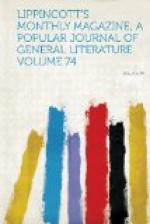On a rock at the summit of a hill commanding this interesting city stands the fort of Fatehgarh, built by a certain Afghan adventurer, Dost Mohammed Khan, who, in a time when this part of India must have been a perfect paradise for all the free lances of the East, was so fortunate as to win the favor of Aurungzebe, and to receive as evidence thereof a certain district in Malwa. The Afghan seems to have lost no time in improving the foothold thus gained, and he thus founded the modern district of Bhopal, which was formerly divided between Malwa and Gondwana, one gate of the town standing in the former and one in the latter country. Dost Mohammed Khan appears, indeed, to have been not the only adventurer who bettered his fortunes in Bhopal. It is a curious fact, and one well illustrating the liberality which has characterized much of the more modern history of the Bhopal government, that no long time ago it was administered by a regency consisting of three persons—one a Hindu, one a Mohammedan, and the other a Christian. This Christian is mentioned by Sir John Malcolm as “Shahzed Musseah, or Belthazzar Bourbona” (by which Sir John means Shahzahad Messiah—a native appellation signifying “the Christian prince”—or Balthazar of Bourbon), and is described by that officer, to whom he was well known, as a brave soldier and an able man. He traced his lineage to a certain Frenchman calling himself John of Bourbon, who in the time of Akbar was high in favor and position at Delhi. His widow, the princess Elizabeth of Bourbon, still resides at Bhopal in great state, being possessed of abundant wealth and ranking second only to the Begum. She is the acknowledged head of a large number of descendants of John of Bourbon, amounting to five or six hundred, who remain at Bhopal and preserve their faith—having a church and Catholic priest of their own—as well as the traditions of their ancestry, which, according to their claim, allies them to the royal blood of France.
No mention of Bhopal can fail to pay at least a hasty tribute in commemoration of the forcible character and liberal politics of the Begum, who has but of late gone to her account after a long and sometimes trying connection with the administration of her country’s affairs. After the death of her husband—who was accidentally killed by a pistol in the hands of a child not long after the treaty with the English in 1818—their nephew, then in his minority, was considered as the future nawab, and was betrothed to their daughter, the Begum being regent during his minority. When the time came, with his majority, for the nuptials, the Begum refused to allow the marriage to take place, for reasons which need not here be detailed. After much dispute a younger brother of the nephew was declared more eligible, but the Begum still managed in one way or another to postpone matters, much to his dissatisfaction. An arbitration finally resulted in placing him on the throne, but




